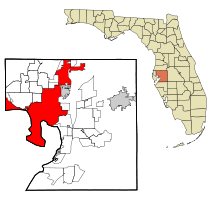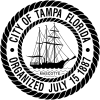Tampa
| Tampa, Florida | |||
|---|---|---|---|
| City | |||
| City of Tampa | |||

Images from top, left to right: Skyline of Downtown Tampa, Amalie Arena, Ybor City, Henry B. Plant Museum, Raymond James Stadium, Busch Gardens Tampa Bay
|
|||
|
|||
| Nickname(s): Cigar City,The Big Guava | |||
 Location in Hillsborough County and the state of Florida |
|||
| Location in the United States | |||
| Coordinates: 27°58′05″N 82°28′35″W / 27.96806°N 82.47639°WCoordinates: 27°58′05″N 82°28′35″W / 27.96806°N 82.47639°W | |||
| Country |
|
||
| State |
|
||
| County |
|
||
| Settled | 1823 | ||
| Incorporated (Village) | January 18, 1849 | ||
| Incorporated (Town) | September 10, 1853 and August 11, 1873 |
||
| Incorporated (City) | December 15, 1855 * and July 15, 1887 |
||
| Government | |||
| • Type | Mayor-council | ||
| • Mayor | Bob Buckhorn (D) | ||
| • Legislative | Tampa City Council | ||
| Area | |||
| • City | 170.6 sq mi (441.9 km2) | ||
| • Land | 112.1 sq mi (290.3 km2) | ||
| • Water | 58.5 sq mi (151.6 km2) 34.3% | ||
| • Urban | 802.3 sq mi (2,078 km2) | ||
| • Metro | 2,554 sq mi (6,610 km2) | ||
| Elevation | 48 ft (14.6 m) | ||
| Population (2013) | |||
| • City | 369,075 | ||
| • Rank | 53rd in the US | ||
| • Density | 2,969.6/sq mi (1,146.7/km2) | ||
| • Urban | 2.4 million (17th) | ||
| • Metro | 2,824,724 | ||
| Demonym(s) | Tampan, Tampanian | ||
| Time zone | EST (UTC-5) | ||
| • Summer (DST) | EDT (UTC-4) | ||
| ZIP codes | 33601–33626, 33629–33631, 33633–33635, 33637, 33647, 33650–33651, 33655, 33660–33664, 33672–33675, 33677, 33679–33682, 33684–33690, 33694, 33697 | ||
| Area code(s) | 813 | ||
| FIPS code | 12-71000 | ||
| GNIS feature ID | 0292005 | ||
| Website | www.tampagov.net | ||
| * Original city charter revoked by Florida Legislature on October 4, 1869 | |||
Tampa (/ˈtæmpə/) is a major city in, and the county seat of, Hillsborough County, Florida. It is located on the west coast of Florida on Tampa Bay, near the Gulf of Mexico, and is part of the Tampa Bay Metropolitan Area. The city had a population of 346,037 in 2011.
The current location of Tampa was once inhabited by indigenous peoples of the Safety Harbor culture (most notably the and the Pohoy, who lived along the shores of Tampa Bay). The area was explored by Spanish explorers in the 16th century, resulting in violent conflicts and the introduction of European diseases, which wiped out the original native cultures. Although Spain claimed Florida as part of New Spain, it did not found a colony in the Tampa area, and there were no permanent American or European settlements within today's city limits until after the United States acquired Florida from Spain in 1819.
In 1824, the United States Army established a frontier outpost called Fort Brooke at the mouth of the Hillsborough River, near the site of today's Tampa Convention Center. The first civilian residents were pioneers who settled near the fort for protection from the nearby Seminole population, and the small village was first incorporated as "Tampa" in 1849. The town grew slowly until the 1880s, when railroad links, the discovery of phosphate, and the arrival of the cigar industry jump-started its development, helping it to grow from a quiet village of less than 800 residents in 1880 to a bustling city of over 30,000 by the early 1900s.
...
Wikipedia



